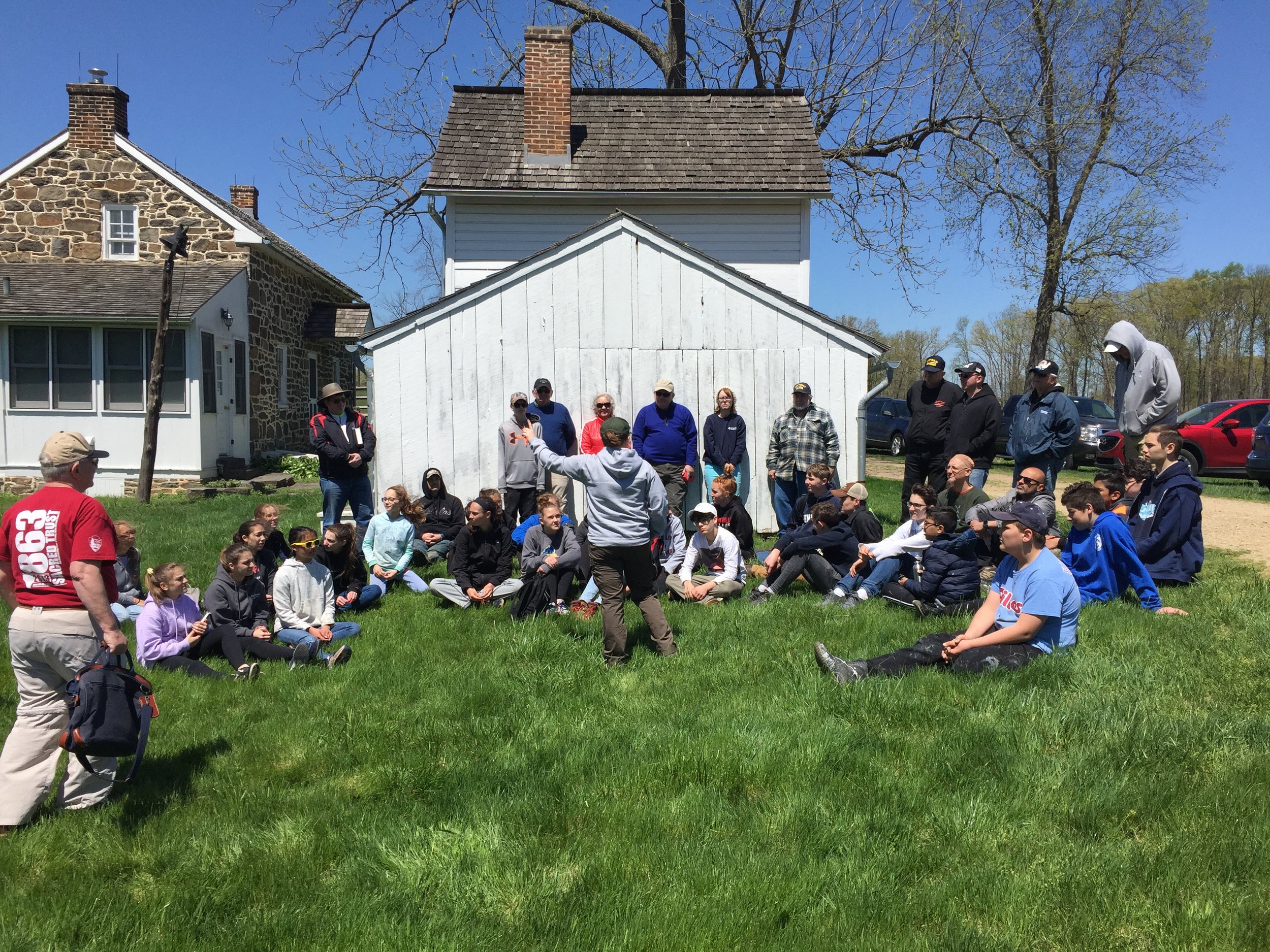Saturday April 27th saw fifty CWRT members, friends and family, along with Boy Scouts and students and teachers from Saucon Valley High School spend the day in Gettysburg National Military Park working at the John Slyder Farm.
This years’ annual work day consisted of painting the LONG fence bordering the driveway and building fencing in the back pasture of the Slyder Farm.
What a fantastic (though windy) day in the park. Following lunch we were treated to a presentation by Volunteer Coordinator Kaitlin Brown concerning the history of the farm, and the events which occurred there during the days of battle in early July 1863.
THANK YOU to all who helped plan the event and work to preserve Gettysburg as a place of history and learning.
[Photos from the day are below]
__________________________________________
The following history of the farm is from “Barns of the Civil War” website (click here for site)
John Slyder moved to Gettysburg in 1838 coming across the Mason-Dixon line from Carroll County, Maryland and worked as a potter. Slyder made a career change and purchased a 75 acre tract of land in 1849 and began building a farm. He built his home, several outbuildings like a blacksmith shop and a carpentry shop along with a double log barn on the property. He dug a well which provided a good source of water and planted a peach and pear orchard which produced exceptional fruit. The property also included a 30 acre timber lot and an 18 acre meadow. Slyder used the blacksmith shop to manufacture tools for other local farms. At the time of the battle John lived on the farm with his wife Catherine and three of his five children, John (age 20), Hannah (17) and Jacob (9). The family was directed to leave on July 2 by Union patrols and the family heeded their warning.
One of the most controversial aspects of the Battle of Gettysburg is how long it took the Confederates to get into position to attack on July 2 and what their actual plan was. It was nearly 4 PM when the last of John Bell Hood’s division got into position. These men were Alabamians under the command of Evander Law. They had began their day near what is today Caledonia State Park and had been marching since around 4 am. It was a hot day with temperatures reaching the upper 80s and high humidity. When they arrived at Gettysburg they immediately began marching to get into position to attack. No rest for the weary and no time to refill empty canteens.
Opposing Hood’s men were the soldiers of the United State Sharpshooters. The unit was the brainchild of Hiram Berdan, a New York inventor and championship marksman and was formed in July 1861. These men were crack shots. In order to qualify for the outfit a recruit had to hit 10 consecutive bulls-eyes from both a standing position at 200 yards and 100 yards offhanded. The men were trained to be used as skirmishers and were given a green uniform rather than the standard blue, an early attempt at camouflage. The were ordered to seek out targets of importance like officers. They were also armed with breech loading rifles to increase their firepower. Originally their use of these much more modern weapons was overruled but Berdan went over the heads of the generals directly to Abraham Lincoln and put on a dazzling display of what these new rifles could do. Lincoln was sold and the sharpshooters got their breech loading rifles. These soldiers may be the first special forces soldiers in American military history.
About 170 sharpshooters from the 2nd US Sharpshooter regiment took position along the Slyder farm lane behind a stone fence. Law’s exhausted and parched soldiers advanced against them, probably ruing not being able to stop and get a drink in the stream. The sharpshooters began taking their toll on the Alabamians but they could not hold long. Law’s 1,500 men eventually got around their flank and the sharpshooters fell back. Some of these Alabamians continued on toward their date with destiny on the slopes of Little Round Top, others headed towards Devil’s Den.
The US Sharpshooters had bought time. It may have only been ten minutes or so but that time allowed other Union soldiers to move into position on Little Round Top and immortality. The sharpshooters lost about 25% of their men to do so but they may have saved the nation. After falling back many of the sharpshooters also helped to defend Little Round Top. The farm also saw an ill-fated cavalry charge on July 3 that was doomed before it began and resulted in the death of Union general Elon Farnsworth.
The farm was used as a field hospital by the Confederates. The home was ransacked and the property was left in shambles with all of the family’s possessions stolen. A damage claim was filed with the government but as was common for many other Gettysburg residents it was never paid. In September of 1863 Slyder, on the verge of bankruptcy, picked up his family and moved to Ohio. The farm was eventually purchased by the National Park Service. Several outbuildings were relocated to the farm in an attempt to make it a working farm again in the 1970s to help educate the public about farming in the Civil War. The project was axed due to budgetary problems in the 1980s though some education groups are brought to the farm to learn about the impact of the war on farmers. The farm was used for filming of the 1993 movie Gettysburg and the home was used for the interior of Robert E. Lee’s headquarters. The farm is accessible by walking on the horse trail, either from West Confederate Avenue or South Confederate






























































































